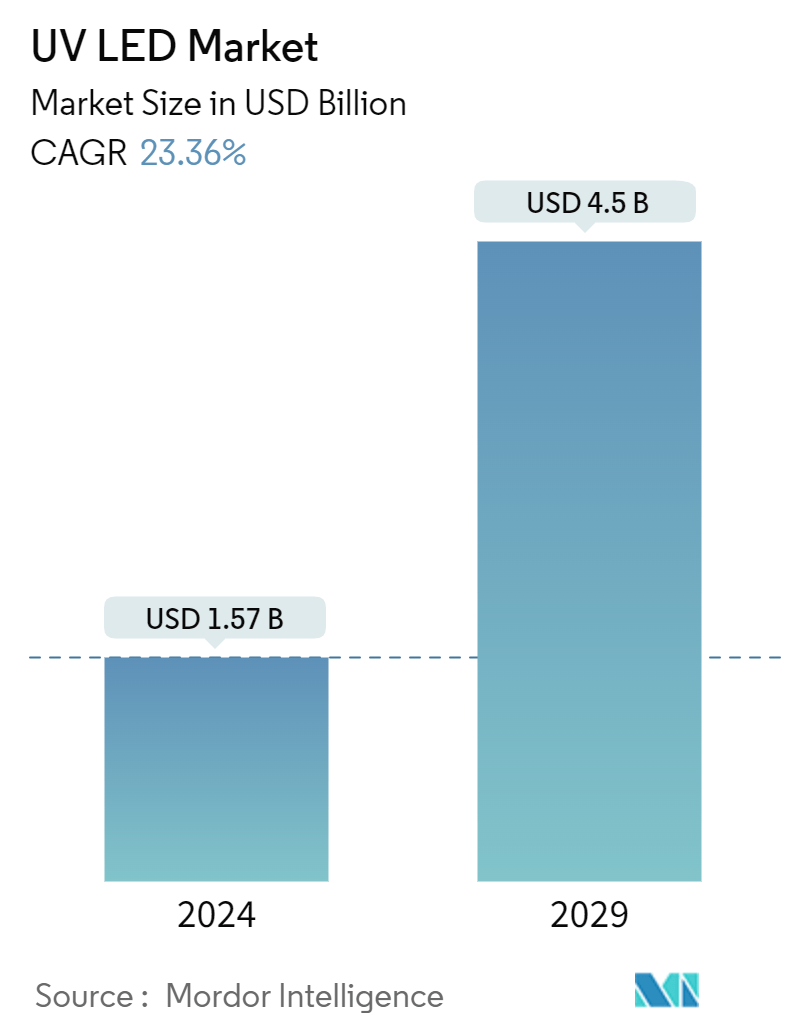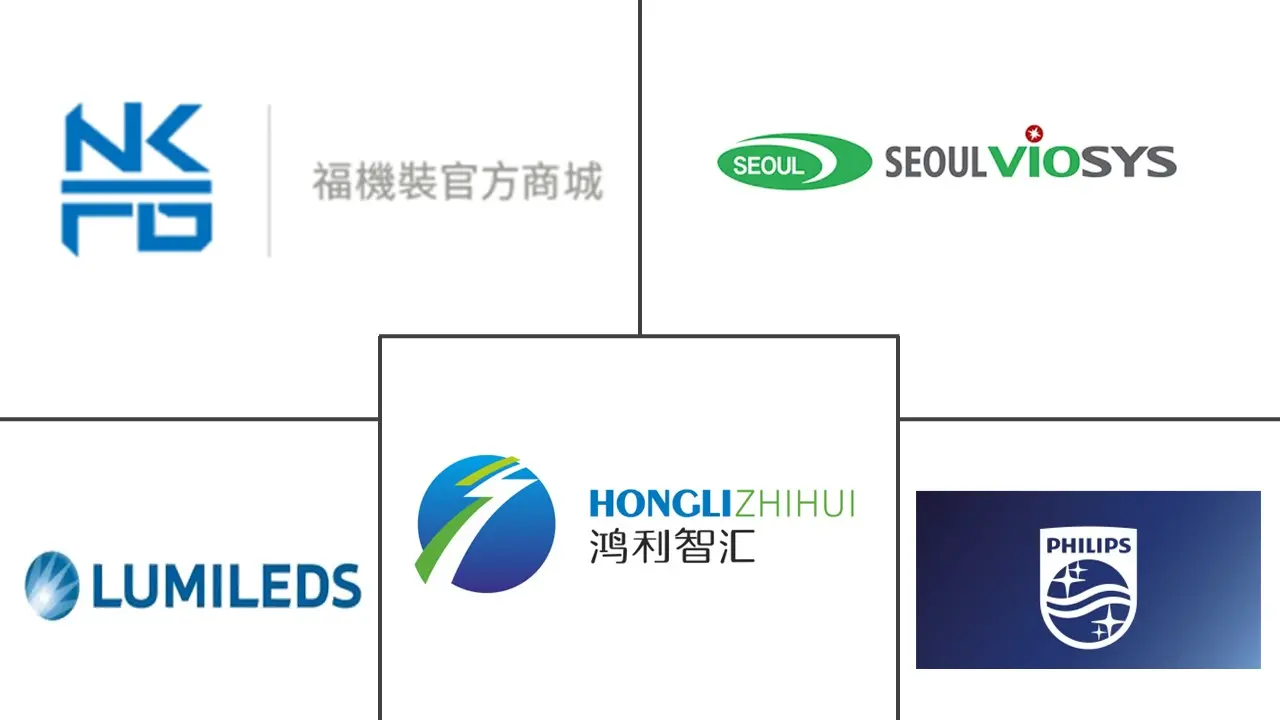Market Size of UV LED Industry

| Study Period | 2019 - 2029 |
| Market Size (2024) | USD 1.57 Billion |
| Market Size (2029) | USD 4.5 Billion |
| CAGR (2024 - 2029) | 23.36 % |
| Fastest Growing Market | Asia Pacific |
| Largest Market | Asia Pacific |
Major Players
*Disclaimer: Major Players sorted in no particular order |
UV LED Market Analysis
The UV LED Market size is estimated at USD 1.57 billion in 2024, and is expected to reach USD 4.5 billion by 2029, growing at a CAGR of 23.36% during the forecast period (2024-2029).
The growing demand for UV LEDs across different applications and increasing efforts made by vendors to enhance the technology further, giving rise to new use cases, are anticipated to support the growth of the market studied during the forecast period.
In recent years, the adoption of LEDs has grown significantly in applications wherein UV lamps (mercury, excimer, xenon, amalgam, etc.) have operated for decades. Recent technological improvements in the flux density, stability, and operating hours of UV-LEDs have also made them an efficient solution for replacing traditional UV light sources such as arch lamps, hot and cold cathode lamps, mercury arc lamps, and grid lamps. Moreover, the fact that UV LEDs are more environmentally friendly, as they do not use harmful mercury, consume less energy, and do not produce ozone, also supports its adoption across various applications.
In optoelectronics, UV LEDs consist of approximately 200 nm to 400 nm products with various package styles, including surface mount, through-hole, and COB (chip-on-board). There are many unique applications for UV LEDs. However, the application cases of these LEDs are greatly dependent on the output power and wavelength.
In the last decade, the prominence of LED technology has grown significantly, driven by increasing consumer acceptance and technological innovations. For instance, according to estimates by the European Commission's Joint Research Center and the International Energy Agency (IEA), the penetration of LEDs in the lighting industry is estimated to grow to 87.4% by 2030, from just 1.8% in 2012. Such trends are anticipated to drive the awareness and acceptance of LED technology, creating a favorable outlook for the market studied.
However, factors such as the higher cost of UV LEDs and the negative impact of UV light on users' health are significant challenges for the market's growth. Furthermore, lower efficiency and issues related to the reliability of UV LEDs may challenge the growth of the market studied.
With the outbreak of COVID-19, the global UV LED market witnessed a significant growth in demand due to its effectiveness in disinfecting surfaces and germ-killing properties. The healthcare sector received a significant boost post-pandemic, which is anticipated to drive the demand for advanced solutions for sterilization and disinfection applications.
UV LED Industry Segmentation
The market is defined by the revenue accrued from the sales of UV LEDs by various vendors globally. UV LED (ultraviolet light-emitting diode) is a device that emits ultraviolet light or waves with a wavelength of less than 400 nm and is renowned for its compact size, high performance, and low cost. UV LED technology has evolved and witnessed tremendous growth, owing to its increasing applications in curing, purification, and medical fields, such as skin treatment, medical devices, disinfection areas, printing, and the gemological field.
The UV LED market is segmented by technology (UV-A, UV-B, and UV-C), application (optical sensor and instrumentation, counterfeit detection, sterilization, UV curing, medical light therapy, and other applications), and geography (North America [United States and Canada], Europe [Germany, United Kingdom, and France], Asia-Pacific (China, Japan, South Korea, Australia, and New Zealand), Latin America (Brazil, Chile, and Mexico) and Middle East and Africa (United Arab Emirates and South Africa). The report offers market forecasts and size in value (USD) for all the above segments.
| By Technology | |
| UV-A | |
| UV-B | |
| UV-C |
| By Application | |
| Optical Sensors and Instrumentation | |
| Counterfeit Detection | |
| Sterilization | |
| UV Curing | |
| Medical Light Therapy | |
| Other Applications |
| By Geography*** | ||||||
| ||||||
| ||||||
| ||||||
| ||||||
|
UV LED Market Size Summary
The UV LED market is poised for significant growth, driven by increasing demand across various applications and advancements in technology that are expanding its use cases. The shift from traditional UV light sources to UV LEDs is supported by improvements in flux density, stability, and operational efficiency, making them a more sustainable and energy-efficient option. The market is experiencing a surge in adoption due to the environmental benefits of UV LEDs, such as the absence of harmful mercury, reduced energy consumption, and no ozone production. This transition is further bolstered by the growing awareness and acceptance of LED technology, particularly in the lighting industry, which is expected to continue its upward trajectory.
The COVID-19 pandemic has accelerated the demand for UV LED solutions, particularly in the healthcare sector, due to their effectiveness in disinfection and sterilization applications. The focus on hygiene in industries like healthcare, hospitality, and public spaces has increased the adoption of UV-C LED technologies, which offer shorter disinfection times and reduced chemical usage. The market is also witnessing advancements in UV-C LED technology, enhancing efficiency, lifespan, and affordability. The integration of UV-C LEDs into consumer products and household appliances presents new opportunities for market expansion. Additionally, the growing use of UV LED technology in UV curing processes, especially in the automotive and electronics industries, is expected to drive further market growth in regions like Asia-Pacific. The market remains highly competitive, with major players engaging in strategic partnerships and product innovations to maintain their competitive edge.
UV LED Market Size - Table of Contents
-
1. MARKET INSIGHTS
-
1.1 Market Overview
-
1.2 Industry Attractiveness - Porter's Five Forces Analysis
-
1.2.1 Bargaining Power of Suppliers
-
1.2.2 Bargaining Power of Buyers
-
1.2.3 Threat of New Entrants
-
1.2.4 Threat of Substitutes
-
1.2.5 Intensity of Competitive Rivalry
-
-
1.3 Impact of COVID-19, After Effects, and Other Macroeconomic Factors
-
-
2. MARKET SEGMENTATION
-
2.1 By Technology
-
2.1.1 UV-A
-
2.1.2 UV-B
-
2.1.3 UV-C
-
-
2.2 By Application
-
2.2.1 Optical Sensors and Instrumentation
-
2.2.2 Counterfeit Detection
-
2.2.3 Sterilization
-
2.2.4 UV Curing
-
2.2.5 Medical Light Therapy
-
2.2.6 Other Applications
-
-
2.3 By Geography***
-
2.3.1 North America
-
2.3.1.1 United States
-
2.3.1.2 Canada
-
-
2.3.2 Europe
-
2.3.2.1 Germany
-
2.3.2.2 United Kingdom
-
2.3.2.3 France
-
-
2.3.3 Asia-Pacific
-
2.3.3.1 China
-
2.3.3.2 Japan
-
2.3.3.3 South Korea
-
2.3.3.4 Australia and New Zealand
-
-
2.3.4 Latin America
-
2.3.4.1 Brazil
-
2.3.4.2 Chile
-
2.3.4.3 Mexico
-
-
2.3.5 Middle East and Africa
-
2.3.5.1 United Arab Emirates
-
2.3.5.2 South Africa
-
-
-
UV LED Market Size FAQs
How big is the UV LED Market?
The UV LED Market size is expected to reach USD 1.57 billion in 2024 and grow at a CAGR of 23.36% to reach USD 4.5 billion by 2029.
What is the current UV LED Market size?
In 2024, the UV LED Market size is expected to reach USD 1.57 billion.

